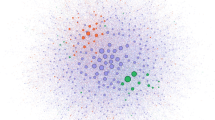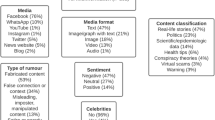Abstract
The outbreak of the global COVID-19 pandemic has been accompanied by what the World Health Organization has described as an ‘infodemic’: the rapid and uncontrolled dissemination of misinformation and disinformation relating to the virus across online and offline social networks and media outlets. Focusing particularly on the conspiracy theory that the coronavirus outbreak was somehow linked to the rollout of 5G telephony technology, which circulated since late January 2020 and culminated in arson attacks on mobile phone towers in the United Kingdom and other countries in early April, this chapter traces the trajectory of this conspiracy theory across social, fringe, and mainstream media. Drawing on data from Facebook and the global media database GDELT, we show how early claims of a link between COVID-19 and 5G that originated with far-right and alternative health groups and outlets circulated among fringe networks before receiving substantial amplification as minor and major celebrities, as well as tabloid and entertainment media outlets, began to share such stories. This detailed case study is illustrative of the dissemination dynamics for misinformation and disinformation well beyond the COVID-19/5G case itself; it also points to the key inflection points at which the spread of such misinformation may be reduced.
Access this chapter
Tax calculation will be finalised at checkout
Purchases are for personal use only
Similar content being viewed by others
Notes
- 1.
We use the terms ‘misinformation’ and ‘disinformation’ together in this article as they are distinguished by intentionality (Wardle & Derakhshan, 2017, p. 20): misinformation is false information that is shared in the mistaken belief that the information is accurate, while disinformation deliberately aims to confuse and mislead. For the purposes of our analysis in this chapter, however, this distinction is irrelevant: whether it is shared deliberately or unintentionally, in either case, the end result is that incorrect information is disseminated further.
References
Allport, G., & Postman, L. (1946). An Analysis of Rumor. Public Opinion Quarterly, 10(4), 501–517.
Australian Government. (2020, May 20). 5G misinformation and COVID-19. Retrieved November 2, 2020, from https://www.com-munications.gov.au/departmental-news/5g-misinformation-and-covid-19
Bruns, A. (2019). Are filter bubbles real? Polity Press.
Bruns, A., Harrington, S., & Hurcombe, E. (2020). ‘Corona? 5G? Or both?’: the dynamics of COVID-19/5G conspiracy theories on Facebook. Media International Australia, 177(1), 12–29.
Bruns, A., Hurcombe, E., & Harrington, S. (forthcoming). Covering conspiracy: Mainstream and fringe reporting of the COVID-19/5G conspiracy theory. Digital Journalism.
Chen, A. (2015, June 2). The agency. The New York Times Magazine. https://www.nytimes.com/2015/06/07/magazine/the-agency.html
CrowdTangle. (2020). Facebook. Menlo Park.
De Keulenaar, E., Wilson, J., van der Heide, J., & Kisjes, I. (2020, October). Alt-tech, alt-media, alt-right COVID misinformation after the 2020 ‘summer of deplatforming’. Paper presented at Annual Conference of the Association of Internet Researchers.
Foser, J. (2009, September 4). Stenography vs. Journalism. Media Matters for America. Retrieved November 2, 2020, from https://www.mediamatters.org/legacy/stenography-v-journalism
Gleicher, N. (2018, December 6). Coordinated inauthentic behavior explained. Facebook Newsroom. https://newsroom.fb.com/news/2018/12/inside-feed-coordinated-inauthentic-behavior
Kleinman, Z. (2020, January 27). UK to decide on Huawei 5G ban. BBC News. Retrieved November 2, 2020, from https://www.bbc.com/news/technology-51263800
Leetaru, K., & Schrodt, P. A. (2013). GDELT: Global data on events, location, and tone, 1979–2012. International Studies Association.
Nyhan, B., & Reifler, J. (2010). When corrections fail: The persistence of political misperceptions. Political Behaviour, 32, 303–330.
Osborne, C. (2020, April 30). 5G mast arson, coronavirus conspiracy theories force social media to walk a fine censorship line. ZDNet. Retrieved November 2, 2020, from https://www.zdnet.com/article/amid-5g-mast-arson-and-coronavirus-conspiracy-theories-social-media-walks-a-fine-line
UK Government. (2020, May 6). 5G and coronavirus (COVID-19). Retrieved November 2, 2020, from https://www.gov.uk/guidance/5g-and-corona-virus-covid-19
United Nations. (2020a, March 31). The UN tackles ‘infodemic’ of misinformation and cybercrime in COVID-19 crisis. Retrieved November 2, 2020, from https://www.un.org/en/un-coronavirus-communications-team/un-tackling-%E2%80%98infodemic%E2%80%99-misinformation-and-cybercrime-covid-19
United Nations. (2020b, November 2). COVID-19: 5G broadband conspiracy ‘a hoax with no technical basis’. Retrieved February 2, 2021, from https://news.un.org/en/story/2020/04/1062362
Wardle, C., & Derakhshan, H. (2017). Information disorder: Toward an interdisciplinary framework for research and policy making. Strasbourg: Council of Europe. Retrieved November 2, 2020, from https://rm.coe.int/information-disorder-toward-an-interdisciplinary-framework-for-researc/168076277c
Acknowledgements
This research is supported by the Australian Research Council projects DP200101317 Evaluating the Challenge of ‘Fake News’ and Other Malinformation and FT130100703 Understanding Intermedia Information Flows in the Australian Online Public Sphere. Axel Bruns, Stephen Harrington, and Edward Hurcombe acknowledge continued support from the Queensland University of Technology (QUT) through the Digital Media Research Centre. Facebook data are provided courtesy of CrowdTangle.
Author information
Authors and Affiliations
Corresponding author
Editor information
Editors and Affiliations
Rights and permissions
Copyright information
© 2021 The Author(s), under exclusive license to Springer Nature Switzerland AG
About this chapter
Cite this chapter
Bruns, A., Harrington, S., Hurcombe, E. (2021). Coronavirus Conspiracy Theories: Tracing Misinformation Trajectories from the Fringes to the Mainstream. In: Lewis, M., Govender, E., Holland, K. (eds) Communicating COVID-19. Palgrave Macmillan, Cham. https://doi.org/10.1007/978-3-030-79735-5_12
Download citation
DOI: https://doi.org/10.1007/978-3-030-79735-5_12
Published:
Publisher Name: Palgrave Macmillan, Cham
Print ISBN: 978-3-030-79734-8
Online ISBN: 978-3-030-79735-5
eBook Packages: Literature, Cultural and Media StudiesLiterature, Cultural and Media Studies (R0)




